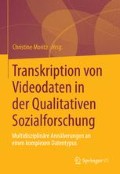Zusammenfassung
In den letzten Jahren gewann die Kontextrepräsentation große Bedeutung in Bereichen wie Ambient Assisted Living (AAL), Geschichten erzählen oder Affective Computing. Einer der Gründe dafür ist nicht nur die Einschätzung der Reaktionen des Benutzers oder des Schauspielers auf bestimmte Ereignisse, sondern auch das Verständnis für den Grund diesen Reaktionen. Eine der Techniken für die richtige Beschreibung von täglichen Ereignissen ist die Semantische Analyse verbunden mit Ontologien. Ontologien sind die formalen geordneten Darstellungen einer Menge von Begrifflichkeiten und der zwischen ihnen bestehenden Beziehungen in einem bestimmten Gegenstandsbereich. Mit dieser Arbeit legen wir unser Modell vor, um tägliche Ereignisse in der Welt (Kontext) eines Charakters zu beschreiben und automatisch zu generieren. Dieser Kontext wird die Emotionen der Charaktere beeinflussen und auslösen.
Access this chapter
Tax calculation will be finalised at checkout
Purchases are for personal use only
Preview
Unable to display preview. Download preview PDF.
Literaturverzeichnis
Arellano D, Varona J, Perales F. J (2008) Generation and visualization of emotional states in virtual characters. Computer Animation and Virtual Worlds (CAVW) 19(3-4): 259–270. DOI: 10.1002/cav.263.
Arellano D, Lera I, Varona J, Perales F. J (2009) Integration of a semantic and affective model for realistic generation of emotional states in virtual characters. ACII09.
Bekiaris E, Bonfiglio S (2009) The OASIS Concept. Proceedings of the 5th International Conference on Universal Access in Human-Computer Interaction. Addressing Diversity. Part I: Held as Part of HCI International 2009 (UAHCI ‚09) 202–209. DOI=10.1007/978-3-642-02707-9_22
Cataldi M, Damiano R, Lombardo V, Pizzo A (2011) Representing dramatic features of stories through an ontological model. In Proceedings of the 4th international conference on Interactive Digital Storytelling (ICIDS’11)122–127. DOI=10.1007/978-3-642-25289-1_13 Springer-Verlag, Berlin, Heidelberg.
Cearreta I, Garay N (2011) Applying the affinto ontology to develop a text-based emotional conversation system. Proceedings of the 13th IFIP TC 13 international conference on Human-computer interaction – Volume Part IV (INTERACT’11)479–482. ISBN: 978-3-642-23767-6 Springer- Verlag, Berlin, Heidelberg.
Forchheimer F, Pandzic I. S (1996) MPEG-4 facial animation The Standard, Implementation and Applications. John Wiley and Sons, West Sussex, UK.
Gómez-Romero J, Bobillo F, Delgado M (2011) Context Representation and Reasoning with Formal Ontologies. Proceedings of the 1st Workshop on Activity Context Representation: Techniques, Languages 26–31
Jewell M, Lawrence K, TuM (2005) OntoMedia: An ontology for the representation of heterogeneous media. Proceedings of SIGIR workshop on Multimedia Information Retrieval. ACM SIGIR.
Klein M, Schmidt A, Lauer R (2007) Ontology-Centred Design of an Ambient Middleware for Assisted Living. Proceedings of the 30th Annual German Conference on Artificial Intelligence (KI 2007): Towards Ambient Intelligence: Methods for Cooperating Ensembles in Ubiquitous Environments (AIM-CU).
Ortony A, Clore G, Collins, A (1998) Cognitive Structure of Emotions. New York, NY: Cambridge University Press.
Schapp R (2009) Enhancing video game characters with emotion, mood and personality. Master’s thesis, Delft University of Technology.
Strang T, Popien C.L (2004) A Context Modeling Survey. UbiComp 1st International Workshop on Advanced Context Modelling, Reasoning and Management 31–41
Winer D (2011) Review of Ontology Based Storytelling Devices. In: Nahum Dershowitz and Ephraim Nissan . Language, Culture, Computation: Essays in Honour of Yaacov Choueka, Vol. 2: Tools for Text and Language, and the Cultural Dimension.
Author information
Authors and Affiliations
Corresponding author
Editor information
Editors and Affiliations
Rights and permissions
Copyright information
© 2014 Springer Fachmedien Wiesbaden
About this chapter
Cite this chapter
Arellano, D., Varona, J., Perales, F. (2014). Beschreibung von täglichen Ereignissen für die Kontextrepräsentation. In: Moritz, C. (eds) Transkription von Video- und Filmdaten in der Qualitativen Sozialforschung. Springer VS, Wiesbaden. https://doi.org/10.1007/978-3-658-00879-6_8
Download citation
DOI: https://doi.org/10.1007/978-3-658-00879-6_8
Published:
Publisher Name: Springer VS, Wiesbaden
Print ISBN: 978-3-658-00878-9
Online ISBN: 978-3-658-00879-6
eBook Packages: Humanities, Social Science (German Language)

